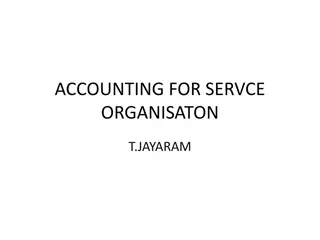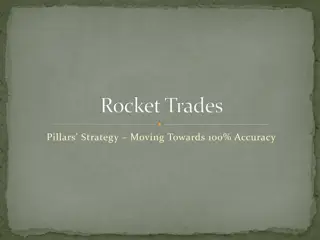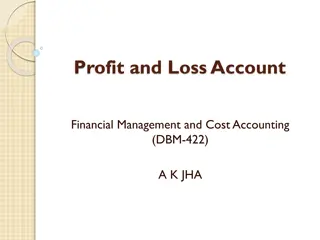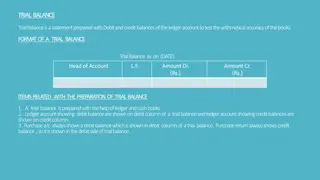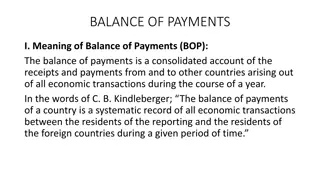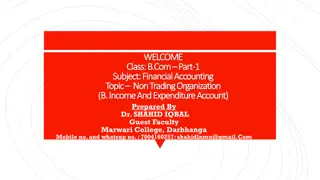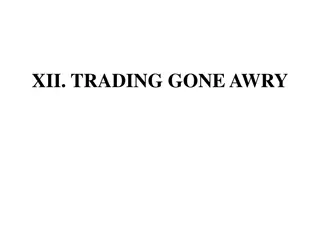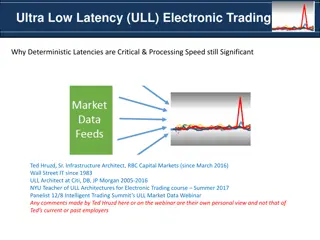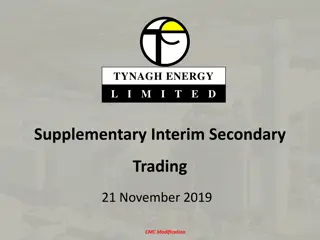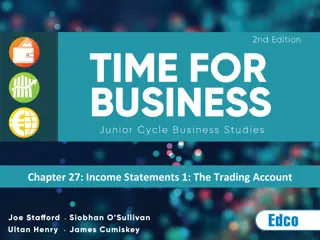Introduction and Preparation of Trading Account in Financial Management
Financial statements play a crucial role in understanding a firm's financial position and profitability. They include a Balance Sheet, Profit and Loss Account, and schedules. Trading Account is the initial step in final accounts preparation, focusing on gross profit or loss. It helps determine the profitability of the business through buying, selling, or manufacturing and selling activities. The purpose of the Trading Account is to calculate gross profit by matching selling prices with the cost of goods sold or services rendered.
Download Presentation

Please find below an Image/Link to download the presentation.
The content on the website is provided AS IS for your information and personal use only. It may not be sold, licensed, or shared on other websites without obtaining consent from the author. Download presentation by click this link. If you encounter any issues during the download, it is possible that the publisher has removed the file from their server.
E N D
Presentation Transcript
Introduction and Preparation of Trading Account Financial Management and Cost Accounting (DBM-422) A K JHA
Financial Statement Financial Statements are prepared to get an idea of profit or loss as well as the financial position of the firm or business. It is prepared at the end of the financial year. The financial statements are useful for the users in understanding the position and status of business and making decisions accordingly. A set of financial statements includes a Balance Sheet a Profit and LossAccount Schedules and notes forming part of balance sheet, and Profit and LossAccount.
Financial Statement Financial Statements are prepared from the Trial Balance to get an idea of: How much profit was earned in a particular period? Profit and LossAccount shows the profit earned during the year. What is financial position of the business at the end of a particular period? Balance Sheet is a position statement that shows the financial position on a particular date. Balance sheet and Profit and Loss Accounts are the Final Statements or Accounts . They are the end product of FinancialAccounting. Income statement is the summary of accounts that affects the profit or loss of an enterprise. An Income Statement has two parts: 1. TradingAccount:It reveals gross profit or gross loss 2. Profit and LossAccount:It reveals net profit and net loss
Trading Account Meaning: Trading Account is prepared to know profitability of business due to buying and selling or manufacturing and selling. It shows the profit from the main business; buying and selling other than the business isn t included inTradingAccount. Trading Account is the first stage in preparing a final account. It shows the gross profit or gross loss during an accounting year. Its includes sales, services rendered in the credit side and cost of such sales and services rendered in the debit side. Features ofTradingAccount 1. It is the first stage in preparation of final accounts. 2. It records only net sales and direct cost of goods sold. 3. The balance of this account discloses the gross profit or gross loss. 4. The balance of this account is transferred to the Profit and Loss Account.
Purpose of Trading Account It is prepared to find out the gross profit or gross loss during the accounting year. It is based on matching the selling price of goods and services with the cost of goods sold and services rendered.
Contents of Trading Account 1. Opening Stock refers to the closing balance of the previous year. It is generally put as first item on the debit side of the Trading account In case of trader, the opening stock consists of different types of finished goods. For manufacturing, the opening stock consists of raw materials, work in process and finished goods 2. Purchases and Purchase Returns The purchase account shows a debit balance, showing the gross amount of purchases made of the materials. This refers to the goods purchased, both cash and credit purchases for resale. The purchase of assets meant for permanent use in business such as furniture, machinery are not included
The Purchase Returns Account shows a credit balance showing the returns of materials to the suppliers. On the debit side of the trading account, the net amount is shown as: Rs To Purchase Less: Purchases Returns 3,00,000 10,000 2,90,000 Apart from the purchases returns, following entries should also be deducted Goods taken by the proprietor for his personal use. Goods given as charity. Goods given as samples. Items shown on the Credit Side of the Trading Account 1. Sales and Sales Returns 2. Closing Stock
3. Direct Expenses those expenses which are incurred on the goods purchased till they are brought to the place of business for sale e.g. Freight inward, insurance, import duty, etc. In manufacturing business wages, power and fuel, factory rent, etc. are also direct expenses. Stores consumed during the last year = Opening Balance in Stores + Purchase of Sores during the year Closing Balance of Stores
Balancing of Trading Account Gross Profit or Gross Loss After recording the above items in the respective sides of the Trading Account, the balance is calculated to ascertain Gross Profit and Gross Loss. If the total of the credit side is more than that of debit side, the excess is Gross Profit. If the total of the debit side is more than that of credit side, the excess is Gross Loss.
Advantage of Trading Account 1.The various items of trading can be known separately. 2.Over stocking or under stocking can be known 3.The result of trading can be known separately. 4.The progress can be studied on the basis of gross profit ratio, year by year
Name of the Firm Trading Account For the year ended on 31st March Dr. Cr. Particulars To Opening stock To Purchase less return To Wages To Carriage To Freight To Fuel To Stores consumed To Royalty To Manufacturing Expenses To Profit and Loss A/c Balancing figure Gross Profit (transferred to P and L A/c) Amount Particulars By Sales less Returns By Stock Balancing figure Gross (transferred to P and L A/c) Amount Closing loss
Example1. Prepare a Trading Account for the year ending March 31, 2019 from the following balances as at March 31, 2019 Particulars Opening stock :Raw material Finished Goods Purchase Sales Returns: Purchase Sales Wages Factory Expenses Freight : In wards Out wards At the period of the concerned period the stock on hand were: Raw Material Work in progress Finished Goods Amount (Rs) 20000 35000 90000 175000 2500 1500 32500 22500 5000 7500 17500 5000 27500
Name of the Firm Trading Account For the year ending March 31, 2019 Dr. Cr. Particulars Amount (Rs) 20000 35000 87500 32500 22500 5000 21000 Particular Amount (Rs) 173500 17500 5000 27500 To Opening Stock: Raw Material Finished goods To Purchases 90000 Less Return 2500 To Wages To Factor Expenses To Freight Inwards To Gross Profit Total By 175000 Less 1500 By Stock: Raw Materials Work in process Finished goods Sales: :Return Closing 223500 223500




![Guardians of Collection Enhancing Your Trading Card Experience with the Explorer Sleeve Bundle [4-pack]](/thumb/3698/guardians-of-collection-enhancing-your-trading-card-experience-with-the-explorer-sleeve-bundle-4-pack.jpg)





